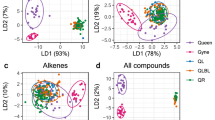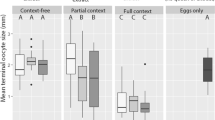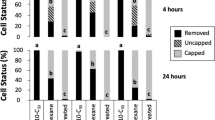Abstract
The substance produced by the mandibular gland complex (HQMC) of queen honey bees is considered to be responsible for retinue formation in honey bees, Apis mellifera L.1–3. The retinue response includes the licking and antennating behaviour which signals the presence of a dominant reproductive queen and thereby establishes and stabilizes the social fabric of the colony. Despite 25 years of research, none of the known constituents of HQMC extract4,5 has been effective in eliciting full retinue behaviour. We report that the mandibular-gland-based retinue response is mediated by five semiochemicals. Each component is weakly active alone, but the complete blend imparts activity equivalent to HQMC extract at a level as low as 10–7 of that present in a queen.
This is a preview of subscription content, access via your institution
Access options
Subscribe to this journal
Receive 51 print issues and online access
$199.00 per year
only $3.90 per issue
Buy this article
- Purchase on Springer Link
- Instant access to full article PDF
Prices may be subject to local taxes which are calculated during checkout
Similar content being viewed by others
References
Gary, N. E. Science 133, 1479–1480 (1961).
Velthuis, H. H. W. Behavior 41, 105–129 (1972).
Butler, C. G., Callow, R. K., Koster, C. G. & Simpson, J. J. Apic Res. 12, 159–166 (1973).
Callow, R. K., Chapman, J. R. & Paton, P. N. J. Apic. Res. 3, 77–89 (1964).
Simpson, J. J. Apic. Res. 18, 233–249 (1979).
Slessor, K. N., King, G. G. S., Miller, D. R., Winston, M. L. & Cutforth, T. L. J. chem. Ecol. 11, 1659–1667 (1985).
Pain, J., Hugel, M.-F. & Barbier, M. C. r. Acad. Sci. Paris 251, 1046–1048 (1960).
Barbier, M., Lederer, E., Reichstein, T. & Schindler, O. Helv. chim. Acta 43, 1682–1689 (1960).
Barbier, M. & Lederer, E. C. r. Acad. Sci. Paris 250, 4467–4469 (1960).
Callow, R. K. & Johnston, N. C. Bee World 41, 152–153 (1960).
Silverstein, R. M. & Young, J. C. in Pest Management with Insect Sex Attractants (ed. Beroza, M.) 1–29 (Am. Chem. Soc., Washington, 1976).
Butler, C. G. & Fairey, E. M. J. Apic. Res. 3, 65–76 (1964).
Winston, M. L., Slessor, K. N., Smirle, M. J. & Kandil, A. A. J. chem. Ecol. 8, 1283–1288 (1982).
Crewe, R. M. & Velthuis, H. H. W. Naturwissenschaften 67, 467–469 (1980).
Howard, A. S., Michael, J. P. & Schmidt, M. A. S. Afr. Tydskr. Chem. 34, 132–133 (1981).
Kleinbaum, D. G. & Kupper, L. L. Applied Regression Analysis and Other Multivariable Methods (Duxbury, North Scituate, 1978).
Borden, J. H., Chong, L., McLean, J. A., Slessor, K. N. & Mori, K. Science 192, 894–896 (1976).
Lanier, G. N., Classon, A., Stewart, T., Piston, J. J. & Silverstein, R. M. J. chem. Ecol. 6, 677–687 (1980).
Millar, J. G., Pierce, H. D. Jr, Pierce, A. M., Oehlschlager, A. C. & Borden, J. H. J. chem. Ecol. 8, 1071–1081 (1985).
Zar, J. H. Biostatistical Analysis 2nd edn (Prentice-Hall, Englewood Cliffs NJ 1984).
Author information
Authors and Affiliations
Rights and permissions
About this article
Cite this article
Slessor, K., Kaminski, LA., King, G. et al. Semiochemical basis of the retinue response to queen honey bees. Nature 332, 354–356 (1988). https://doi.org/10.1038/332354a0
Received:
Accepted:
Issue Date:
DOI: https://doi.org/10.1038/332354a0
This article is cited by
-
A Hitchhiker’s Ride: The Honey Bee Louse Braula Coeca (Diptera: Braulidae) Selects its Host by Eavesdropping
Journal of Chemical Ecology (2024)
-
How India Changed My Ideas About Honey Bees
Journal of the Indian Institute of Science (2023)
-
Antenna movements as a function of odorants’ biological value in honeybees (Apis mellifera L.)
Scientific Reports (2022)
-
Honeybee queen mandibular pheromone fails to regulate ovary activation in the common wasp
Journal of Comparative Physiology A (2022)
-
Methoxyfenozide has minimal effects on replacement queens but may negatively affect sperm storage
Apidologie (2022)
Comments
By submitting a comment you agree to abide by our Terms and Community Guidelines. If you find something abusive or that does not comply with our terms or guidelines please flag it as inappropriate.



